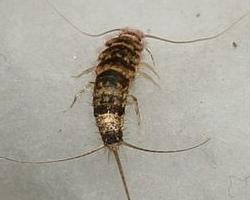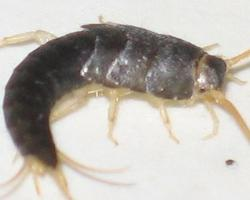
Váhy a míry
| Délka | 1,5 cm |
|---|
Popis zvířete
The Firebrat (Thermobia domestica) is a small, intriguing insect that belongs to the order Zygentoma, sharing its classification with the closely related silverfish. This creature is particularly fascinating due to its preference for warm environments, which has earned it the name "Firebrat." With a cosmopolitan distribution, it has successfully made its way into human habitats around the globe, thriving in environments that are heated by human activity.An adult Firebrat measures approximately 1.0 to 1.5 cm in length, not including its tail, and possesses a slender, elongated body that is somewhat flattened. The body is covered in fine scales that lend it a somewhat bristly appearance. These scales can vary in color from mottled gray to a more silvery or even shiny brown hue, allowing the Firebrat to blend into its surroundings with remarkable efficiency.
One of the most distinctive features of the Firebrat, much like its silverfish cousin, is its three long, thread-like appendages that extend from the rear of its body. These are not true tails but cerci and a median filament, which serve as sensory organs helping the insect navigate its environment, detect predators, and communicate with potential mates.
The Firebrat's head is equipped with large, compound eyes and long, slender antennae that are constantly moving, scanning the environment for food sources and potential threats. Despite their prominent eyes, Firebrats, like other members of their order, rely heavily on their antennae for navigation due to their primarily nocturnal nature and the dark environments they inhabit.
Firebrats have a remarkable ability to withstand high temperatures, thriving in environments that range between 32°C to 41°C (90°F to 105°F). This preference for warmth often leads them to reside near boilers, furnaces, ovens, and other heat-generating appliances in human dwellings. Unlike many insects, Firebrats do not undergo metamorphosis and instead develop through a series of molts, with the nymphs resembling smaller versions of the adults.
Their diet is as varied as their habitats, consisting of carbohydrates such as sugar and starches. They are known to feed on a wide array of household items, including glue, paper, book bindings, and even some textiles, which can make them a pest in certain situations.
Reproduction in Firebrats is a fascinating process that involves a series of ritualistic dances and movements by both the male and female. After mating, the female lays batches of eggs in cracks, crevices, or other hidden spots within their warm habitats. These eggs hatch into nymphs, which then undergo numerous molts before reaching adulthood.
Despite their preference for warmth and their occasional pest status, Firebrats play a role in the ecosystem as decomposers, breaking down and recycling organic material. However, their presence in homes and businesses can lead to damage of paper goods, textiles, and contaminate food products, making them unwelcome guests for many people.
In summary, the Firebrat (Thermobia domestica) is a small, heat-loving insect with a widespread presence due to its ability to thrive in human-modified environments. Its unique physiology and behaviors make it a subject of interest not only for those studying insects but also for those looking to understand how species adapt to and exploit human habitats.
Podobná zvířata
Nové fotografie zvířat
Top 10 zvířat
- Chinese water dragon (Physignathus cocincinus)
- Galápagos tortoise (Geochelone nigra complex)
- Dolphin gull (Leucophaeus scoresbii)
- Japanese macaque (Macaca fuscata)
- Colombian red howler (Alouatta seniculus)
- Sea urchins (Echinoidea)
- Moustached guenon (Cercopithecus cephus)
- Diana monkey (Cercopithecus diana)
- Common reed warbler (Acrocephalus scirpaceus)
- Common house mosquito (Culex pipiens)
